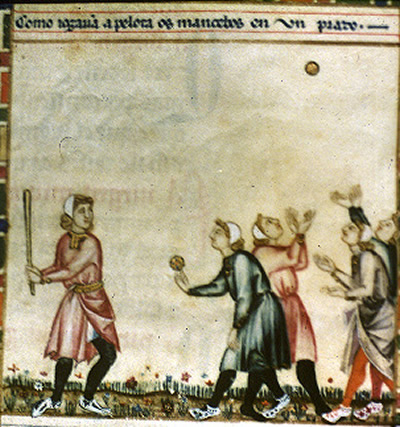
Here is the sequel to the previous post, in which I demonstrated on the basis of a thirteenth-century manuscript image that we should be wary of origin stories. This post has more to say about the story for which the image was originally produced. A ballgame among friends now becomes just the opening act in an opera about love, betrayal, and redemption. Here is the full-page storyboard-type illustration from the manuscript, and below is my rough translation of the medieval Galician in the accompanying text:
It happened in Germany that a miracle was done by the Virgin Mary when a false lover turned his attention from one love to another.
There were some people renovating a Church and they took from the high altar a sculpted image of Her Majesty, putting it outside in the door of a patio under a portico.

Near that plaza was a field where people went to catch the sun and where they played a ball game that the young men liked to play more than any other. On this occasion, a group arrived that included a young man who was enamored with a young girl he was close to, who had given him a ring. Thinking the ball could damage the ring, he went to look for a place to put it, saw the lovely statue, and he placed the ring on its finger, saying “From now on I won’t give myself to the woman I loved because I swear to God I have never seen anything as beautiful as you. And so I promise that from now on I will become your servant, and I will give you this ring as a sign.” Kneeling before her and saying an “Ave Maria” he promised that from then on never would he have feelings for another woman, and that he would be loyal.

As he stood up, the statue closed its finger around the ring and, upon seeing this the lad was filled with surprise and exclaimed “Oh, Holy Mary, count me worthy!” When people heard him shouting, they came running and he told them what had happened. Then they advised him to enter the monastery of the Cistercian monks.

Everyone believed that he had done it, but, on the advice of the devil, things turned out otherwise than he had so urgently promised the Virgin, and so it all left his mind, like water gets drawn out of salt. He forgot about the Glorious Virgin after that, fell in love with his first girlfriend again, and, to please the parents, married her, and left the pleasure of the other world for earthly pleasures.

When the wedding was complete and the day was done, he got into bed first and quickly fell asleep. Then, in his dreams he saw Holy Mary, who called to him angrily “Look, my false liar, why did you depart from me and look for another woman? You made me a promise and gave me a ring. That is why you need to leave her immediately and come with me, or else from now on you will suffer mortal anguish.
He woke up, but he did not want to go, so the Glorious Virgin made him go to sleep again, and then she put herself between him and the girl, separating them, calling out in a rage “You evil, false, disloyal… Are you coming? Aren’t you ashamed that you have left me behind? Well, if you love me, you will get up right now and come with me, don’t wait until tomorrow, leave this house. Leave!

Then the boyfriend woke up and, filled with terror, got up and started on his way so fast that he didn’t even call two or three lads to join him. He passed through mountains for a month until he rested in a hermitage beside a stand of pine trees. From that time on, according to what is written, he served Holy Mary, mother of the very High King, who took him, according to my belief and knowledge, from this world to Paradise, the Celestial Kingdom.

Wow. What a story. But strange, perhaps needing a bit of explanation. I mean, for instance: How about that cool image of Mary in bed between the just-married couple? What happened to the girl he married?
Now, here’s what I would like you to do…. If you want to know more about some of the oddities of the images, a little bit about how to interpret the story, or more about the Cantigas de Santa Maria (the series of miracle stories produced in the court of Alfonso X “the Wise”), then find the “Leave a Reply” box below and say something so that I know you are paying attention. Ask a question, offer a comment, or just say “More, please!” Thanks.
Do you see other manuscripts created in this time period or in “Spain” in general that show images of people playing baseball or any other reference to this story?
LikeLike
Yes, there are many such images. The image in the El Escorial ms. is from the thirteenth century, around 1280. Here is another one from a Bodleian Library manuscript from the fourteenth century.
LikeLiked by 1 person